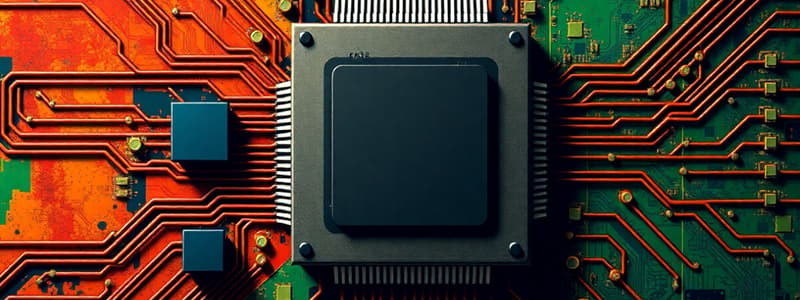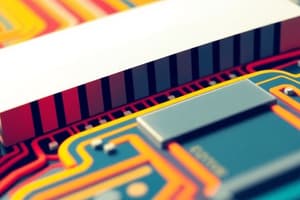Podcast
Questions and Answers
What is the primary function of the Arithmetic/Logic Unit (ALU) in a CPU?
What is the primary function of the Arithmetic/Logic Unit (ALU) in a CPU?
- To store program instructions
- To perform mathematical and logical operations (correct)
- To manage input/output devices
- To decode instructions
What component of the CPU decodes instructions and coordinates the operations of other components?
What component of the CPU decodes instructions and coordinates the operations of other components?
- Control unit (correct)
- Register areas
- Memory
- Input/output devices
Which of the following best describes the purpose of memory in a computer system?
Which of the following best describes the purpose of memory in a computer system?
- To perform logical comparisons
- To decode tasks for the control unit
- To provide high-speed storage for program instructions and data (correct)
- To facilitate data input from external devices
What does decoding an instruction involve?
What does decoding an instruction involve?
Which opcode is used for adding two numbers together?
Which opcode is used for adding two numbers together?
What is a characteristic of a multicore processor?
What is a characteristic of a multicore processor?
Which of the following is an example of a coprocessor?
Which of the following is an example of a coprocessor?
How many cores can modern CPUs typically have?
How many cores can modern CPUs typically have?
Which of the following families is NOT an Intel processor family?
Which of the following families is NOT an Intel processor family?
What capability does a Graphics Processing Unit (GPU) provide while the CPU is engaged in other tasks?
What capability does a Graphics Processing Unit (GPU) provide while the CPU is engaged in other tasks?
Which statement is true about processor families?
Which statement is true about processor families?
What is the primary benefit of having multiple cores in a processor?
What is the primary benefit of having multiple cores in a processor?
What is a key characteristic of Cache Memory?
What is a key characteristic of Cache Memory?
Which statement accurately describes Read-Only Memory (ROM)?
Which statement accurately describes Read-Only Memory (ROM)?
What is a significant advantage of Secondary Data Storage Devices over memory?
What is a significant advantage of Secondary Data Storage Devices over memory?
Why is it necessary to use input/output channels to access secondary storage?
Why is it necessary to use input/output channels to access secondary storage?
Which of the following is NOT a common form of secondary storage?
Which of the following is NOT a common form of secondary storage?
What is parallel computing primarily defined as?
What is parallel computing primarily defined as?
Which of the following best describes massively parallel processing systems?
Which of the following best describes massively parallel processing systems?
What is grid computing primarily characterized by?
What is grid computing primarily characterized by?
Which example illustrates grid computing effectively?
Which example illustrates grid computing effectively?
What does Main Memory provide to the CPU?
What does Main Memory provide to the CPU?
Which statement is true about Random Access Memory (RAM)?
Which statement is true about Random Access Memory (RAM)?
How many bits are there in a byte?
How many bits are there in a byte?
What is a common misconception about massively parallel processing systems?
What is a common misconception about massively parallel processing systems?
Which characteristic is NOT a feature of grid computing?
Which characteristic is NOT a feature of grid computing?
What does main memory primarily rely on for data storage?
What does main memory primarily rely on for data storage?
Flashcards are hidden until you start studying
Study Notes
CPU Components
- The CPU consists of three main components: the Arithmetic/logic unit (ALU), the control unit, and the register areas.
- The ALU performs arithmetic operations such as addition, subtraction, multiplication, and division, as well as logical comparisons.
- The control unit decodes instructions and coordinates the operations of other CPU components.
- The register areas are small, high-speed storage areas within the CPU.
Memory
- Memory provides a working storage area for program instructions and data.
Input/Output Devices
- Input/output devices provide data and instructions to the computer and receive results from it.
- This includes permanent storage.
Instruction Processing
- Completing an instruction involves four steps:
- Fetching the instruction from memory
- Decoding the instruction
- Executing the instruction
- Storing the result
Decoding
- Decoding involves breaking down the instruction into two parts: opcode (operation code) and address code.
- Opcodes are a basic set of commands that the processor can execute, such as ADD, COMPARE, IN, and JUMP.
Processor Families
- A set of processors from the same manufacturer that have similar features and capabilities.
- Examples include Intel families: Atom, Celeron, Pentium, Core, Xeon and Ryzen FX.
Utilizing Multiple Processing Units
- A coprocessor executes specific types of instructions while the CPU works on another processing activity.
- Examples include the Graphics Processing Unit (GPU) and the Apple Neural Engine (ANE).
- A multicore processor has two or more independent processing units, called cores.
- These cores can run multiple instructions at the same time, increasing the amount of processing that can be completed in a given amount of time.
Parallel Computing
- Parallel computing involves the simultaneous execution of the same task on multiple processors.
- Massively parallel processing systems have thousands of processors in one system.
Grid Computing
- Grid computing uses a collection of computers, often owned by multiple individuals or organizations, that work in a coordinated manner to solve a common problem.
- Examples include the Large Hadron Collider (LHC) and volunteer computing.
Main Memory
- Provides the CPU with a working storage area for programs and data.
- Also known as Random Access Memory (RAM).
- RAM is temporary and volatile.
- Storage capacity is measured in bytes (B), with one byte representing eight bits that represent a single character of data.
Cache Memory
- Is a type of high-speed memory that the processor can access faster than main memory.
- Located on or near the CPU chip.
Types of Memory
- Read-Only Memory (ROM) is nonvolatile, providing permanent storage for data and instructions.
- ROM chips store essential programming required to start up a computer.
Secondary Data Storage Devices
- Secondary storage devices store large amounts of data and programs more permanently than memory.
- Advantages over memory include nonvolatility, greater capacity, and lower cost.
- Secondary storage is not directly accessible by the CPU.
- Most common forms include magnetic (hard disk drives), optical (CD, DVD, Blu-ray discs), and solid state (SSD, USB memory sticks).
Network-Attached Storage (NAS)
- A storage device (or server) directly connected to a network.
- Each NAS consists of one or several hard disk drives and has its own network address.
Enterprise Storage Options
- Storage Area Networks (SAN) are high-performance networks dedicated to storage, typically used by large businesses and enterprises.
- Storage as a Service (Cloud Storage) is hosted remotely and accessed over the internet.
- Cloud storage is a convenient and scalable option for businesses of all sizes.
Input and Output Devices
- Allow the user to provide data and instructions to the computer and receive results.
- Are part of a computer's user interface.
- Organizations should consider their business goals when selecting input and output devices.
Studying That Suits You
Use AI to generate personalized quizzes and flashcards to suit your learning preferences.




